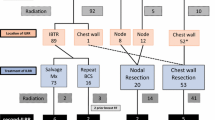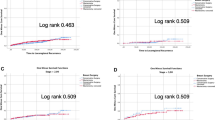Abstract
Background
To define the factors associated with increased risk of isolated locoregional failure that may justify postmastectomy radiotherapy in patients with T1/2 breast cancer and 1–3 positive lymph nodes.
Methods
Between 1990 and 2002, 248 patients who had pT1–2 breast cancer and 1–3 positive lymph nodes were treated with mastectomy without radiotherapy (age 32–84, median 54).
Results
Median follow-up time was 82 months (range 2–189 months). For all patients, the 8-year isolated locoregional failure-free rate was 95 %. In univariate analysis, hormone receptor status and administration of hormone therapy were statistically significant factors, and vascular invasion was the borderline significant factor for isolated locoregional failure-free rates (P = 0.0377, 0.0181, and 0.0555, respectively). The 8-year isolated locoregional failure-free rates were 98 % for patients with positive hormone receptor status and 90 % for patients with negative hormone receptor status, 97 % for patients who received hormone therapy and 89 % for patients who did not receive hormone therapy, 92 % for patients with vascular invasion and 97 % for patients without vascular invasion. In multivariate analysis for hormone receptor status and vascular invasion, the former was statistically significant (P = 0.0491) and the latter was borderline significant (P = 0.0664). When patients had both negative hormone receptor and positive vascular invasion status, the 8-year isolated locoregional failure-free rates decreased to 83 %.
Conclusions
With regard to patients who had pT1/2 breast cancer and 1–3 positive lymph nodes, isolated locoregional failure was not common in general; however, patients who had both negative hormone receptor status and vascular invasion were comparatively high-risk patients for isolated locoregional failure.



Similar content being viewed by others
References
Overgaard M, Hansen PS, Overgaard J, Rose C, Andersson M, Bach F, et al. Postoperative radiotherapy in high-risk premenopausal women with breast cancer who receive adjuvant chemotherapy. Danish Breast Cancer Cooperative Group 82b Trial. N Engl J Med. 1997;337:949–55.
Overgaard M, Jensen MB, Overgaard J, Hansen PS, Rose C, Andersson M, et al. Postoperative radiotherapy in high-risk postmenopausal breast-cancer patients given adjuvant tamoxifen. Danish Breast Cancer Cooperative Group DBCG 82c randomised trial. Lancet. 1999;353:1641–8.
Ragaz J, Olivotto IA, Spinelli JJ, Phillips N, Jackson SM, Wilson KS, et al. Locoregional radiation therapy in patients with high-risk breast cancer receiving adjuvant chemotherapy: 20-year results of the British Columbia randomized trial. J Natl Cancer Inst. 2005;97:116–26.
Whelan TJ, Julian J, Wright J, Jadad AR, Levine ML. Does locoregional radiation therapy improve survival in breast cancer? A meta-analysis. J Clin Oncol. 2000;18:1220–9.
Overgaard M. Overview of randomized trials in high risk breast cancer patients treated with adjuvant systemic therapy with or without postmastectomy irradiation. Semin Radiat Oncol. 1999;9:292–9.
Early Breast Cancer Trialists’ Collaborative Group (EBCTCG). Effects of radiotherapy and of differences in the extent of surgery for early breast cancer on local recurrence and 15-year survival: an overview of the randomized trials. Lancet. 2005;366:2087–106.
Recht A, Edge SB, Solin LJ, Robinson DS, Estabrook A, Fine RE, et al. Postmastectomy radiotherapy: clinical practice guidelines of the American Society of Clinical Oncology. J Clin Oncol. 2001;19:1539–69.
NCCN Clinical Practice Guidelines in Oncology. Version 1.2012. Breast Cancer. http://www.nccn.org/professionals/physician_gls/pdf/breast.pdf. Accessed 25 March 2012.
Truong PT, Olivotto IA, Kader HA, Panades M, Speers CH, Berthelet E, et al. Selecting breast cancer patients with T1–T2 tumors and one to three positive axillary nodes at high postmastectomy locoregional recurrence risk for adjuvant radiotherapy. Int J Radiat Oncol Biol Phys. 2005;61:1337–47.
Sharma R, Bedrosian I, Lucci A, Hwang RF, Rourke LL, Qiao W, et al. Present-day locoregional control in patients with t1 or t2 breast cancer with 0 and 1 to 3 positive lymph nodes after mastectomy without radiotherapy. Ann Surg Oncol. 2010;17:2899–908.
Goldhirsch A, Glick JH, Gelber RD, Senn HJ. Meeting highlights: international consensus panel on the treatment of primary breast cancer. J Natl Cancer Inst. 1998;90:1601–8.
Smith BD, Smith GL, Haffty BG. Postmastectomy radiation and mortality in women with T1–2 node-positive breast cancer. J Clin Oncol. 2005;23:1409–19.
Wu SG, He ZY, Li FY, Wang JJ, Guo J, Lin Q, et al. The clinical value of adjuvant radiotherapy in patients with early stage breast cancer with 1 to 3 positive lymph nodes after mastectomy. Chin J Cancer. 2010;29:668–76.
Yang PS, Chen CM, Liu MC, Jian JM, Horng CF, Liu MJ, et al. Radiotherapy can decrease locoregional recurrence and increase survival in mastectomy patients with T1 to T2 breast cancer and one to three positive nodes with negative estrogen receptor and positive lymphovascular invasion status. Int J Radiat Oncol Biol Phys. 2010;77:516–22.
Truong PT, Berthelet E, Lee J, Kader HA, Olivotto IA. The prognostic significance of the percentage of positive/dissected axillary lymph nodes in breast cancer recurrence and survival in patients with one to three positive axillary lymph nodes. Cancer. 2005;103:2006–14.
Overgaard M, Nielsen HM, Overgaad J. Is the benefit of postmastectomy irradiation limited to patients with four or more positive nodes, as recommended in international consensus reports? A subgroup analysis of the DBCG 82 b&c randomized trials. Radioter Oncol. 2007;82:247–53.
Kyndi M, Overgaard M, Nielsen HM, Sørensen FB, Knudsen H, Overgaard J. High local recurrence risk is not associated with large survival reduction after postmastectomy radiotherapy in high-risk breast cancer: a subgroup analysis of DBCG 82 b&c. Radioter Oncol. 2009;90:74–9.
Conflict of interest
None.
Author information
Authors and Affiliations
Corresponding author
About this article
Cite this article
Hamamoto, Y., Ohsumi, S., Aogi, K. et al. Are there high-risk subgroups for isolated locoregional failure in patients who had T1/2 breast cancer with one to three positive lymph nodes and received mastectomy without radiotherapy?. Breast Cancer 21, 177–182 (2014). https://doi.org/10.1007/s12282-012-0369-7
Received:
Accepted:
Published:
Issue Date:
DOI: https://doi.org/10.1007/s12282-012-0369-7




